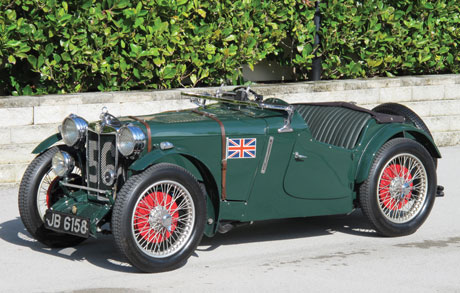Chassis Number: 1711
This car is the sole original survivor of a three-car team put together by MG to publicize the new P-Series, which had been introduced in 1934. The idea was that three identical works cars would be entered in the 1935 Le Mans race, driven by three teams of women, with the whole enterprise to be managed by Captain George Eyston, who had raced at Le Mans in 1928 and 1939.
The press had a field day with Abingdon’s idea, dubbing the six women “Eyston’s Dancing Daughters.”
The cars were carefully assembled at the works at Abingdon, fitted with cycle-type aluminum fenders, aluminum louvered hoods, an aero screen for the driver, luggage space modified for spare tires, special door locks, quick filler caps, racing wheels, radiator and headlights fitted with stone guards, double fuel pumps, Q-Type brakes all around, and J-Type gearbox ratios.
The engines were blueprinted, with lightened flywheel, Q-Type racing valves and springs. The head was polished and an air scoop was fitted to cool the sump.
The six drivers were hardly chosen for public relations value, as all the women had solid racing records, with Brooklands history, club racing, rallies, and hill climb success. Nevertheless “Les Girls at Le Mans” was the dismissive tagline.
The MGs proved themselves bulletproof, with only one light bulb being changed on the number 55 car and the only excitement being an argument with officials about whether one car had been refueled before the required time.
The women silenced their critics with steady progress, and Simpson brought the number 56 car, the example offered here, home in first place among the team. The three cars finished 24th, 25th, and 26th. The cars were then scattered, with C. Miles Collier buying PA 1667 (and it now resides in the Collier Collection) while the two remaining cars, PA 1661 (now missing) and PA 1711 (offered here) were reborn as works hill-climbers, fitted with Marshall superchargers by the factory.
The present owner bought 1711 from Sir Fredrick Royston in 1981, and it was completely restored in 1995. Its history is thoroughly documented, and it will be welcome at any event for which it is eligible. The car is offered with a large file of documentation, including extensive period photography. If, as Sports Car Market magazine publisher Keith Martin says, “The main job of a collector car is to be admired by friends standing around a garage with glasses of wine, while its history is told,” then 1711 will give hours of enjoyment to the next owner—on or off the track.

